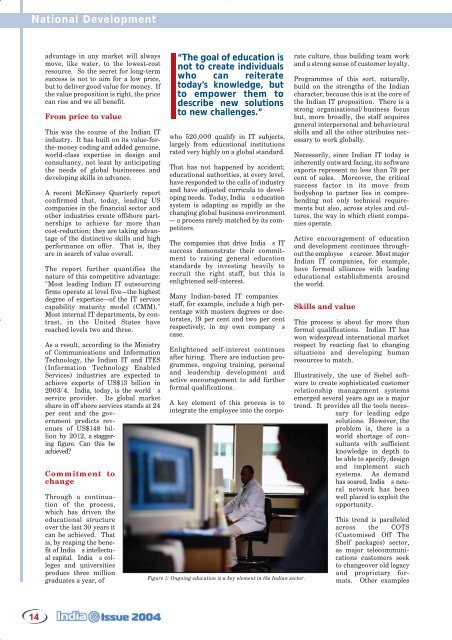Contents - Connect-World
Contents - Connect-World
Contents - Connect-World
You also want an ePaper? Increase the reach of your titles
YUMPU automatically turns print PDFs into web optimized ePapers that Google loves.
National Development<br />
advantage in any market will always<br />
move, like water, to the lowest-cost<br />
resource. So the secret for long-term<br />
success is not to aim for a low price,<br />
but to deliver good value for money. If<br />
the value proposition is right, the price<br />
can rise and we all benefit.<br />
From price to value<br />
This was the course of the Indian IT<br />
industry. It has built on its value-forthe-money<br />
coding and added genuine,<br />
world-class expertise in design and<br />
consultancy, not least by anticipating<br />
the needs of global businesses and<br />
developing skills in advance.<br />
A recent McKinsey Quarterly report<br />
confirmed that, today, leading US<br />
companies in the financial sector and<br />
other industries create offshore partnerships<br />
to achieve far more than<br />
cost-reduction; they are taking advantage<br />
of the distinctive skills and high<br />
performance on offer. That is, they<br />
are in search of value overall.<br />
The report further quantifies the<br />
nature of this competitive advantage:<br />
"Most leading Indian IT outsourcing<br />
firms operate at level five—the highest<br />
degree of expertise—of the IT service<br />
capability maturity model (CMM)."<br />
Most internal IT departments, by contrast,<br />
in the United States have<br />
reached levels two and three.<br />
As a result, according to the Ministry<br />
of Communications and Information<br />
Technology, the Indian IT and ITES<br />
(Information Technology Enabled<br />
Services) industries are expected to<br />
achieve exports of US$13 billion in<br />
2003/4. India, today, is the worlds<br />
service provider. Its global market<br />
share in off shore services stands at 24<br />
per cent and the government<br />
predicts revenues<br />
of US$148 billion<br />
by 2012, a staggering<br />
figure. Can this be<br />
achieved<br />
Commitment to<br />
change<br />
Through a continuation<br />
of the process,<br />
which has driven the<br />
educational structure<br />
over the last 30 years it<br />
can be achieved. That<br />
is, by reaping the benefit<br />
of Indias intellectual<br />
capital. Indias colleges<br />
and universities<br />
produce three million<br />
graduates a year, of<br />
“The goal of education is<br />
not to create individuals<br />
who can reiterate<br />
today’s knowledge, but<br />
to empower them to<br />
describe new solutions<br />
to new challenges.”<br />
who 520,000 qualify in IT subjects,<br />
largely from educational institutions<br />
rated very highly on a global standard.<br />
That has not happened by accident;<br />
educational authorities, at every level,<br />
have responded to the calls of industry<br />
and have adjusted curricula to developing<br />
needs. Today, Indias education<br />
system is adapting as rapidly as the<br />
changing global business environment<br />
— a process rarely matched by its competitors.<br />
The companies that drive Indias IT<br />
success demonstrate their commitment<br />
to raising general education<br />
standards by investing heavily to<br />
recruit the right staff, but this is<br />
enlightened self-interest.<br />
Many Indian-based IT companies<br />
staff, for example, include a high percentage<br />
with masters degrees or doctorates,<br />
19 per cent and two per cent<br />
respectively, in my own companys<br />
case.<br />
Enlightened self-interest continues<br />
after hiring. There are induction programmes,<br />
ongoing training, personal<br />
and leadership development and<br />
active encouragement to add further<br />
formal qualifications.<br />
Figure 1: Ongoing education is a key element in the Indian sector.<br />
A key element of this process is to<br />
integrate the employee into the corporate<br />
culture, thus building team work<br />
and a strong sense of customer loyalty.<br />
Programmes of this sort, naturally,<br />
build on the strengths of the Indian<br />
character, because this is at the core of<br />
the Indian IT proposition. There is a<br />
strong organisational/business focus<br />
but, more broadly, the staff acquires<br />
general interpersonal and behavioural<br />
skills and all the other attributes necessary<br />
to work globally.<br />
Necessarily, since Indian IT today is<br />
inherently outward facing, its software<br />
exports represent no less than 79 per<br />
cent of sales. Moreover, the critical<br />
success factor in its move from<br />
bodyshop to partner lies in comprehending<br />
not only technical requirements<br />
but also, across styles and cultures,<br />
the way in which client companies<br />
operate.<br />
Active encouragement of education<br />
and development continues throughout<br />
the employees career. Most major<br />
Indian IT companies, for example,<br />
have formed alliances with leading<br />
educational establishments around<br />
the world.<br />
Skills and value<br />
This process is about far more than<br />
formal qualifications. Indian IT has<br />
won widespread international market<br />
respect by reacting fast to changing<br />
situations and developing human<br />
resources to match.<br />
Illustratively, the use of Siebel software<br />
to create sophisticated customer<br />
relationship management systems<br />
emerged several years ago as a major<br />
trend. It provides all the tools necessary<br />
for leading edge<br />
solutions. However, the<br />
problem is, there is a<br />
world shortage of consultants<br />
with sufficient<br />
knowledge in depth to<br />
be able to specify, design<br />
and implement such<br />
systems. As demand<br />
has soared, Indias neural<br />
network has been<br />
well placed to exploit the<br />
opportunity.<br />
This trend is paralleled<br />
across the COTS<br />
(Customised Off The<br />
Shelf packages) sector,<br />
as major telecommunications<br />
customers seek<br />
to changeover old legacy<br />
and proprietary formats.<br />
Other examples<br />
14
















